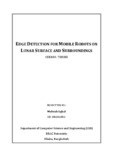Edge detection for mobile robots in Lunar Surface and surroundings
Abstract
The goal of this paper is to explore possibilities in devising a system that is able to detect obstacles in a scene or situation where color variation is limited and environment is noisy, such as that of the moon where there are many craters of different depths and rocks of various sizes and shapes.
The research is premised upon the importance of space research and the dual problem of manned missions to space finances and human survival. For space programs that involve scouting or sample collection from planetary surfaces, it is cost-effective to make use of autonomous or semi-autonomous robots. These robots need to overcome obstacles in lunar/ planetary surface without any hazard, such as falling over, being stuck and so on.
This paper will handle the methods and mechanism of the primary part of this system (obstacle detection) using the moon surface as the destination. Existing algorithms for obstacle detection dealing with edge and corner detection have been compared and modified to best determine obstacles on the lunar surface. In particular shadow masking technique along with edge detection has been used to discern shapes of ditches and mounds on the lunar surface.

